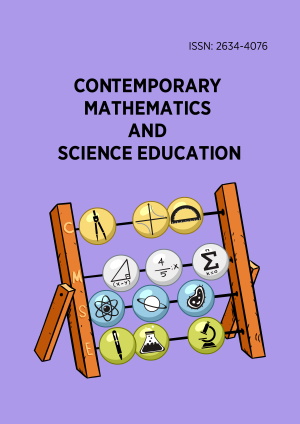Research Article
Implicit Misconceptions in Prospective Mathematics Teachers’ Reasoning About Trigonometric Concepts
More Detail
1 The University of Zambia, Department of Mathematics and Science Education, ZAMBIA* Corresponding Author
Contemporary Mathematics and Science Education, 2(2), July 2021, ep21011, https://doi.org/10.30935/conmaths/11054
Submitted: 17 January 2021, Published: 13 July 2021
OPEN ACCESS 3502 Views 3617 Downloads
ABSTRACT
The likelihood of misunderstanding and misrepresenting trigonometric ideas motivated an investigation of implicit misconceptions in prospective mathematics teachers’ reasoning about particular trigonometric concepts. To access the participants’ implicit misconceptions, a qualitative approach and case study design in particular were employed. Three prospective teachers chosen purposefully composed the sample. The student teachers majored in mathematics and were in the final year of training. Four diagnostic questions based on trigonometry were administered followed by semi-structured interviews. Qualitative analyses of calculations and interview transcripts revealed implicit misconceptions in participants’ reasoning. The prospective teachers reasoned that trigonometric equations can be resolved in the same way as conventional algebraic equations. Likewise, they demonstrated an erroneous notion that inverse trigonometric functions are evaluated just like indices. Besides, the participants incorrectly considered elements of domains of trigonometric functions to be synonymous with such functions’ extreme values. Overall, prospective teachers’ reasoning demonstrated didactical obstacles. It is therefore proposed that mathematics teacher education should include opportunities for prospective teachers to reason about mathematics concepts in a manner that prevents didactical obstacles. Furthermore, mathematics educators should engage in instructional practices which facilitate prospective teachers’ acquisition of in-depth understanding of mathematics conceptual relationships and differences.
CITATION (APA)
Malambo, P. (2021). Implicit Misconceptions in Prospective Mathematics Teachers’ Reasoning About Trigonometric Concepts. Contemporary Mathematics and Science Education, 2(2), ep21011. https://doi.org/10.30935/conmaths/11054
REFERENCES
- Akkoc, H. (2008). Pre-service mathematics teachers’ concept images of radian. International Journal of Mathematical Education in Science & Technology, 39(7), 857-878. https://doi.org/10.1080/00207390802054458
- Ball, D. L., Thames, M. H., & Phelps, G. (2008). Content knowledge for teaching what makes it special? Journal of Teacher Education, 59(5), 389-407. https://doi.org/10.1177/0022487108324554
- Bell, J. (2014). Doing your research project: A guide for first-time researchers: McGraw-Hill Education (UK).
- Bostock, L., & Chandler, S. (2000). Core maths for advanced level. Nelson Thornes.
- Brousseau, G. (1997). Theory of didactical situations in mathematics. Kluwer.
- Buckwell, G. (1996). Mastering advanced pure mathematics. Macmillan Press Ltd. https://doi.org/10.1007/978-1-349-13551-6
- Channon, J. B., Smith McLeish, A., Head, H. C., Macrae, M. F., & Chasakara, A. A. (1994). New general mathematics 4. Longman Group Limited.
- Channon, J. B., Smith McLeish, A., Head, H. C., Macrae, M. F., & Chasakara, A. A. (1996). New general mathematics 3. Longman Group UK Limited.
- Cohen, L., Manion, L., & Morrison, K. (2000). Research methods in education (Fifth Ed.). Routledge Falmer.
- Creswell, J. W. (2012). Educational research planning, conducting, and evaluating quantitative and qualitative research (4th Ed.). Pearson Education.
- Ferguson, R. L. (2007). Constructivism and social constructivism. Theoretical frameworks for research in chemistry/science education, 28-49.
- Fuller, G., & Tarwater, D. (1986). Analytic geometry. Addison-Wesley Publishing Company.
- Hammer, D. (1996). More than misconceptions: Multiple perspectives on student knowledge and reasoning, and an appropriate role for education research. American Journal of Physics, 64, 1316-1325. https://doi.org/10.1119/1.18376
- Laridon, P., Brink, M., Fynn, C., Jawurek, A., Kitto, A., Myburgh, M., Pike, M., Rhodes-Houghton, H., & Rooyen, R. (1995). Classroom mathematics standard 9/grade 11/level 11 (2nd Ed.). Heinemann Publishers.
- Malambo, P. (2015). Exploring Zambian mathematics student teachers’ content knowledge of functions and trigonometry for secondary schools (University of Pretoria). http://hdl.handle.net/2263/52943
- Malambo, P. (2020). Pre-service mathematics teachers’ nature of understanding of the tangent function. JRAMathEdu (Journal of Research and Advances in Mathematics Education), 5(2), 105-118. https://doi.org/10.23917/jramathedu.v5i2.10638
- Malambo, P., Putten, S., Botha, H., & Stols, G. (2018). Mathematics student teachers’ understanding of trigonometry for secondary schools. Nov 2018 11th Annual International Conference of Education, Research and Innovation, Spain. https://doi.org/10.21125/iceri.2018.0748
- Malambo, P., Putten, S., Botha, H., & Stols, G. (2019). Dysfunctional functions: The case of Zambian mathematics education students. Eurasia Journal of Mathematics, Science and Technology Education, 15(1), em1651. https://doi.org/10.29333/ejmste/99510
- Marbán, J., & Sintema, E. (2020). Pre-service secondary teachers’ knowledge of the function concept: A cluster analysis approach. JRAMathEdu (Journal of Research and Advances in MathematicsEducation), 5(1), 38-53. https://doi.org/10.23917/jramathedu.v5i1.9703
- Merriam, S. B. (2009). Qualitative research a guide to design and implementation (2nd Ed.). Jossey-Bass.
- Ministry of Education. (2013a). Zambia education curriculum framework. Zambia Curriculum Development Centre.
- Ministry of Education. (2013b). “O” level mathematics syllabus (Grades 10 to 12). Zambia Curriculum Development Centre.
- Minstrell, J. (1982). Explaining the “at rest” condition of an object. The Physics Teacher, 20(1), 10-14. https://doi.org/10.1119/1.2340924
- Muzangwa, J., & Chifamba, P. (2012). Analysis of errors and misconceptions in the learning of Calculus by undergraduate students. Acta Didactica Napocensia, 5(2), 1-10.
- Nieuwenhuis, J. (2014). Qualitative research designs and data gathering techniques. In K. Maree (Ed.), First steps in research (14th impression ed., pp. 69-97). Van Schaik.
- Ojose, B. (2015). Students’ misconceptions in mathematics: Analysis of remedies and what research says. Ohio Journal of School Mathematics, 72, 30-34.
- Pesen, C. (2007). Students’ misconceptions about fractions. Education and Science, 32(143), 79-88.
- Redspot. (2013). Mathematics topical O level exam papers. Redspot Publishing.
- Talbert, J. F., & Heng, H. (1995). Additional mathematics pure and applied (6th Ed.). Longman Inc.
- Tuna, A. (2013). The influence of the 5E model on the elimination of misconceptions on the subject of trigonometry. International Journal of Academic Research, 5(3). https://doi.org/10.7813/2075-4124.2013/5-3/A.3
- Yasin, A. (2017). A review of research on the misconceptions in mathematics education. Education Research Highlights in Mathematics, Science and Technology, 21-31.

 The articles published in this journal are licensed under the CC-BY Creative Commons Attribution International License.
The articles published in this journal are licensed under the CC-BY Creative Commons Attribution International License.